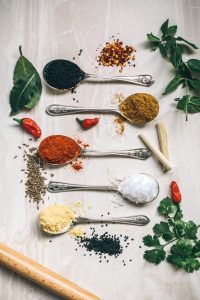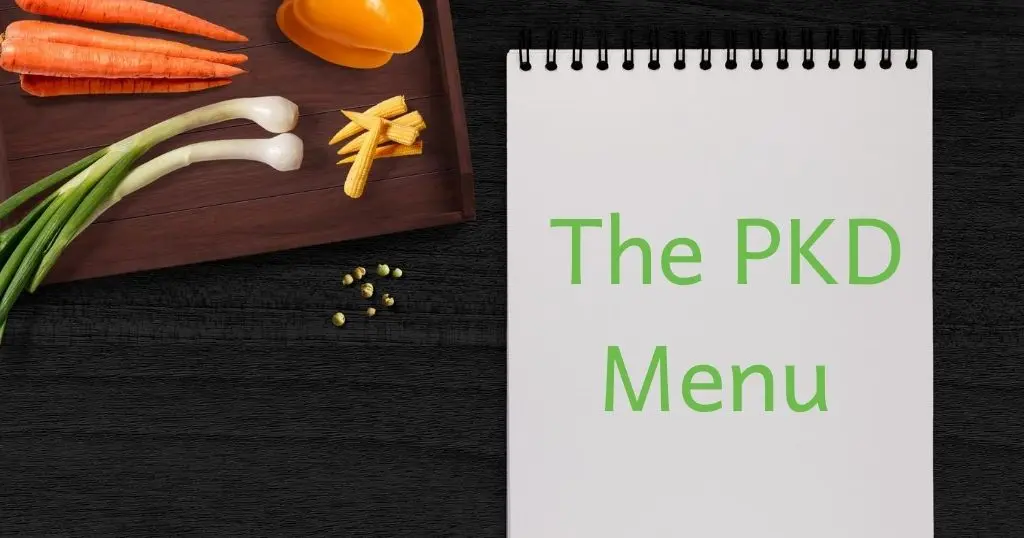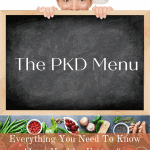*Please note that this post contains clearly identified affiliate links. If you click on these links and choose to make a purchase, I may receive a commission (at no cost to you). As an Amazon Associate I earn from qualifying purchases.
Looking for an example PKD menu? It can be confusing trying to figure out what you actually should be eating for PKD. Combining all the nutrition recommendations for PKD can be overwhelming.
Here is a great 5 day example of a healthy menu for Polycystic Kidney Disease to get you started.
Table of Contents
Pillars of a Healthy PKD Menu
There is a lot to know about a healthy diet for Polycystic Kidney Disease. Here are my top 3 tips for a healthy PKD menu.
Limit Sodium

A low sodium diet is a key feature of a healthy PKD menu. A high sodium diet is associated with faster cyst growth in PKD and can exacerbate blood pressure, swelling and progression of kidney disease.
Aim for no more than 2,300mg of sodium per day. This is about the amount of sodium in 1 teaspoon of salt! Remember that most of the salt we eat is already in our food. You will find large amounts of salt in things like sauces, fried foods, salty snacks, baked goods and frozen foods. Remember, food prepared at restaurants, cafes and grocery stores is another culprit of lots of salt!
Experiment with different herbs and spices to add flavor to your food rather than salt. You may even find some new favorites! For example, my favorite flavors are: dill weed, cumin, chili powder, dry mustard, crushed red pepper flakes, oregano and curry powder.
If you like spice, you can also use small amounts of hot sauce to add lots of flavor to your food with only a small amount of salt.
Rethink Your Protein
For people who are not on dialysis, limiting protein is an important piece of a healthy PKD menu. Work with your dietitian to figure out exactly how much protein you should eat per day.
Good general tips for limiting protein are:
- Limit animal protein portion sizes to 3-6 ounces per meal
- Limit animal protein to no more than 1-2 times per day (if you choose to eat animal protein)
- Swap out animal protein for plant proteins. Plant proteins are less harmful to kidneys. In addition, plant proteins have much less total protein in them compared to animal proteins. Choosing beans, lentils, nuts, seeds or whole grains in place of animal protein will help keep your protein intake in check.
Drink Fluids!
A high fluid intake is key for people with Polycystic Kidney Disease. Studies have found that a very high fluid intake can actually slow the growth of kidney cysts.
A good goal for most people is to drink at least 3 liters of fluid per day. Remember, all fluids count! Most of your fluid should be water, but all fluids count toward your 3 liter goal – even your daily cup of coffee!
Many people find that mixing it up with some more exciting options makes it easier to drink more. Good options are: unsweetened carbonated water (my favorite brands are LaCroix*, Spindrift* & Bubly*), unsweetened tea or water diffused with fruit or fresh herbs.
For a more high tech option, you could try a “smart” water bottle. The HidrateSpark* water bottle connects to a phone app to track how much you drink and even reminds you to drink by lighting up!

The PKD Diet Is Not The Same For Everyone
Remember that a healthy PKD menu is not going to be the same for everyone. Healthy food choices are different based on your medical history, lab values, sex, body size, age, lifestyle and current eating habits.
Potassium on the PKD Menu
Potassium is one of the biggest aspects of a healthy PKD diet that may change person to person. As kidney function declines, your kidneys may not be able to get rid of potassium as well as they should. When this happens, potassium can build up in your body and cause harm. When (and if!) this happens, it may make sense to cut back how much potassium you eat. Until then, potassium is actually a very healthy part of a PKD diet. Most people should actually focus on eating more potassium!
It is always best to work with a Registered Dietitian to figure out what a healthy PKD diet looks like for YOU.
The PKD Menu
Check out this example of what a healthy diet for Polycystic Kidney Disease looks like. Portion sizes will be different based on your energy needs. This menu will give you a general idea of what 5 days of meals and snacks could look like.
This menu is meant for people with PKD who are NOT on dialysis who want to eat to slow the progression of kidney disease and cyst growth. The menu is also fairly high in potassium. If you have very low kidney function, you may need to lower the potassium amounts.
| Example PKD Menu | |||||
|---|---|---|---|---|---|
| Day #1 | Day #2 | Day #3 | Day #4 | Day #5 | |
| Breakfast | Eggs with sauteed peppers & onions Whole Grain toast w/ unsalted butter | Plain Yogurt Blueberries | Crustless Zucchini Quiche Strawberries | Oatmeal with berries and nuts | Avocado Toast w/ pistachios and honey |
| Lunch | Cheese Quesadilla with Homemade Pico de Gallo | Avocado Egg Salad Sandwich Carrot & Celery Sticks | Southwest Black Bean Salad | Low Sodium Turkey sandwich w/ mayo, lettuce & tomato Cucumber slices | Thai Pumpkin Soup |
| Dinner | Spaghetti with Low Sodium Pasta Sauce Side Salad w/ Low Sodium Ranch Dressing | Spicy Black Bean Soup Whole Grain Roll w/ unsalted butter | Honey Mustard Salmon Brown Rice Pilaf Roasted Garlicky Brussels Sprouts | Couscous Stuffed Peppers Side salad w/ olive oil & vinegar dressing | Mixed Vegetable Curry Brown Rice |
| Snack | Unsalted Pretzels String Cheese | Peach | Low Sodium Hummus w/ cucumbers, cherry tomatoes and bell peppers | Yogurt Granola | Grapes |
Happy Eating!
Melanie
For more Polycystic Kidney Disease support, check out my Polycystic Kidney Disease Facebook Community!



I very thank you
I love this thank you ??